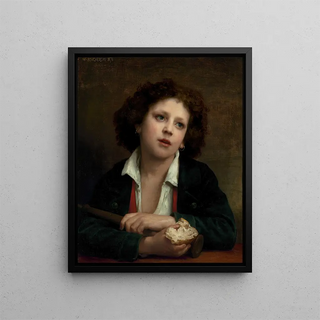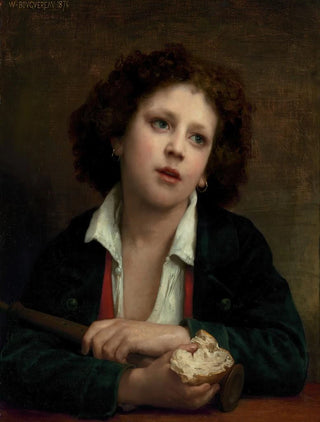Art print | Italian child holding a crust of bread - William Bouguereau


View from behind

Frame (optional)
William Bouguereau's "Italian Child Holding a Crust of Bread" is a true ode to childhood and the simplicity of everyday life. This painting, created at the end of the 19th century, captures the innocence of a young boy, whose sparkling gaze and relaxed posture evoke a palpable tenderness. The scene, imbued with realism, transports the viewer to a world where concerns are reduced to essentials, where bread, a symbol of sustenance, becomes a central element of the composition. Bouguereau succeeds in capturing not only the physical appearance of his subject but also the emotion emanating from it, thus creating an intimate connection between the artwork and the observer.
Style and uniqueness of the artwork
Bouguereau's style is characterized by impressive realism, impeccable technique, and meticulous attention to detail. In "Italian Child Holding a Crust of Bread," every element, from the fabric of the clothing to the nuances of the skin, is treated with precision that reflects his skill. The play of light and shadow, along with a palette of soft colors, contributes to a warm and welcoming atmosphere. The choice of subject, a simple child, far from the grand themes often favored by his contemporaries, reveals the artist's sensitivity to scenes of everyday life. Bouguereau manages to transform a mundane scene into a moment of grace and beauty, inviting the viewer to appreciate the richness of small things.
The artist and his influence
William Bouguereau, born in 1825, was a French painter who marked his era with his academic style and his ability to depict the human figure with rare precision. Trained at the École des Beaux-Arts in Paris, he quickly gained notoriety and became one of the most respected artists of his time. His influence extends beyond his era, inspiring many contemporary and future artists. Bouguereau knew how to combine tradition and innovation, integrating elements of classical painting while exploring modern themes. His work "Italian Child Holding a Crust of Bread"

Matte finish

View from behind

Frame (optional)
William Bouguereau's "Italian Child Holding a Crust of Bread" is a true ode to childhood and the simplicity of everyday life. This painting, created at the end of the 19th century, captures the innocence of a young boy, whose sparkling gaze and relaxed posture evoke a palpable tenderness. The scene, imbued with realism, transports the viewer to a world where concerns are reduced to essentials, where bread, a symbol of sustenance, becomes a central element of the composition. Bouguereau succeeds in capturing not only the physical appearance of his subject but also the emotion emanating from it, thus creating an intimate connection between the artwork and the observer.
Style and uniqueness of the artwork
Bouguereau's style is characterized by impressive realism, impeccable technique, and meticulous attention to detail. In "Italian Child Holding a Crust of Bread," every element, from the fabric of the clothing to the nuances of the skin, is treated with precision that reflects his skill. The play of light and shadow, along with a palette of soft colors, contributes to a warm and welcoming atmosphere. The choice of subject, a simple child, far from the grand themes often favored by his contemporaries, reveals the artist's sensitivity to scenes of everyday life. Bouguereau manages to transform a mundane scene into a moment of grace and beauty, inviting the viewer to appreciate the richness of small things.
The artist and his influence
William Bouguereau, born in 1825, was a French painter who marked his era with his academic style and his ability to depict the human figure with rare precision. Trained at the École des Beaux-Arts in Paris, he quickly gained notoriety and became one of the most respected artists of his time. His influence extends beyond his era, inspiring many contemporary and future artists. Bouguereau knew how to combine tradition and innovation, integrating elements of classical painting while exploring modern themes. His work "Italian Child Holding a Crust of Bread"






